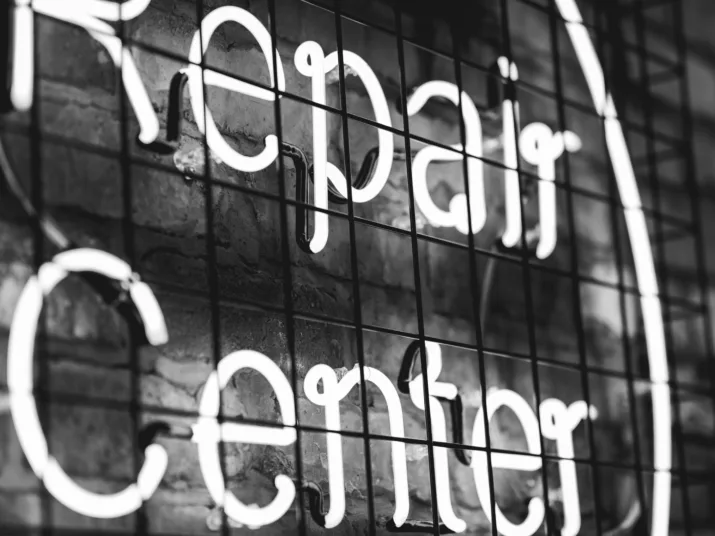
Photo: Dana Vollenweider / Unsplash
WHEN A REPAIR IS WORTH IT
SCREW LOOSE?
The washing machine’s broken down? Off to the Household Waste Recycling Centre. And what about that ageing notebook? A brand new, modern device will replace it. Many things we use in our everyday lives are thrown away after a short time. Instead of shipping new products halfway round the world, the solution is right on our doorsteps: repair them. When does it make sense to grab your toolbox? How does repairing things affect the ecobalance?

Photo: Dana Vollenweider / Unsplash
STATUS QUO: HOW OFTEN ARE THINGS REPAIRED?
A study by the UN [1] shows that the technical lifespan of a washing machine is around 13 years. If it’s subjected to maintenance at the midpoint of its average service life, its functionality can be extended by six years. But that happens rarely: only three per cent of all washing machines are actually refurbished and used again. Notebooks are very often replaced before the end of their lifespan, even though only a quarter of them are actually defective. Of all the household appliances we get rid of, about one third of them are still in working order.
WHAT ARE THE BENEFITS OF A REPAIR?
The resources that can be saved by repairing things can be shown by arithmetical example in the case of a commercial digital printer: from the procurement of the raw material to the ready-to-use product, this kind of device requires a considerable amount of energy. The manufacture of a 900-kilogram digital printer consumes 96,000 megajoules per kilogram and causes 12,000 kilograms of carbon emission. Just to put this in context: repairing the same device generates an average of only 260 megajoules per kilogram and 36 kilograms of carbon emission. Producing a new commercial digital printer requires about 980 kilograms of steel, while parts for its repair require an average of only one kilogram. [2]
Whether it’s repaired, modernised or upcycled – in each case, energy consumption, material costs and carbon emissions are less than ten per cent compared to a new product. From a financial point of view, too, it’s worth reaching for the screwdriver: consumers save about 80 per cent of the original price of every product they bring in for repair or maintenance. And our individual environmental balances improve too: up to 90 per cent of waste can be avoided through repairs.
A SECOND LIFE FOR EVERYDAY OBJECTS
To give people greater encouragement to have their devices repaired – as this has fallen somewhat out of fashion – many initiatives are already pointing to new directions. In Germany alone, 1,000 drop-in workshops, 600 repair cafés and 50 FabLabs (small high-tech workshops) exist to give broken everyday objects a new lease of life. Those of us who are not yet proficient in the use of wrenches and 3D printers can either learn from other users or participate in special workshops. Expert volunteers help with repairs and give advice on how we can do things ourselves.
An example from the Belgian region of Flanders shows how repairs have even arrived in the retail sector. The “REVISIE” quality seal, which is widely accepted, labels electrical appliances that have been successfully repaired or refurbished. The goods had previously been dropped off as “rubbish” at recycling centres. The Flemish second-hand trade chain De Kringwinkel sells the appliances and to this end closely cooperates with regional waste management companies. In 2015, 31 re-use centres repaired, cleaned and put back into circulation e-waste. Around 250 people work in the sector and 128 shops sell the upcycled devices.
WHAT NEEDS TO HAPPEN?
The examples show that new approaches aimed at promoting repairs are already being tested. However, in their study the United Nations researchers also make it clear that a lot still needs to change in our society before repairing things becomes the norm. Everyone is called upon to participate: policymakers must draw up the regulations needed to facilitate both the infrastructures for the repair of goods and the acceptance of those repaired goods in the retail sector.
Industry is called upon to accept a change in the rules of the game and to manufacture its products in such a way that consumers themselves, or at least professional repairers, are enabled to get defective devices up and running again. Ultimately, consumers are faced with the question of whether they actually want to use a product to the end of its lifespan or replace it beforehand – perhaps because their tastes or needs have changed – or whether they want to reach for the toolbox themselves or take the device to the repair shop.
[1] United Nations Environment Programme (2018), Redefining Value, The Manufacturing Revolution.
[2] Ibid. p. 74ff.